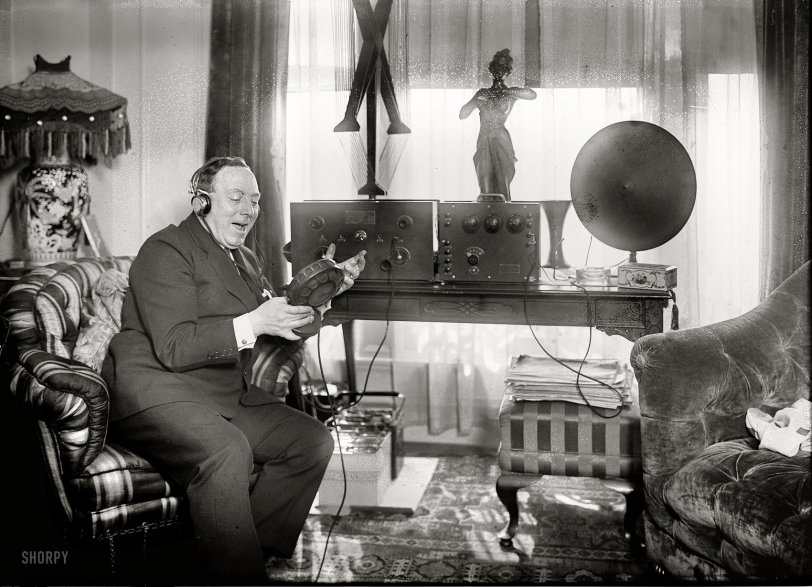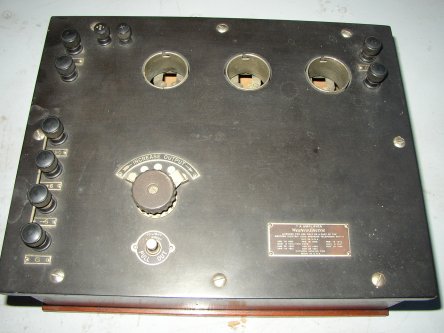


Framed or unframed, desk size to sofa size, printed by us in Arizona and Alabama since 2007. Explore now.
Shorpy is funded by you. Patreon contributors get an ad-free experience.
Learn more.

- Baldwin 62303
- Baldwin VO-1000
- Cold
- No expense spared
- Tough Guys
- Lost in Toyland
- And without gloves
- If I were a blindfolded time traveler
- Smoke Consumer Also Cooks
- Oh that stove!
- Possibly still there?
- What?!?
- $100 Reward
- Freeze Frame
- Texas Flyer wanted
- Just a Year Too Soon
- WWII -- Replacing men with women at the railroad crossing.
- Yes, Icing
- You kids drive me nuts!
- NOT An Easy Job
- I wonder
- Just add window boxes
- Icing Platform?
- Indiana Harbor Belt abides
- Freezing haze
- Corrections (for those who care)
- C&NW at Nelson
- Fallen Flags
- A dangerous job made worse
- Water Stop
Print Emporium
Can You Hear Me Now?

New York circa 1920s. "De Luca." The Italian baritone Giuseppe De Luca, who for many years sang leading roles for the Metropolitan Opera. And who seems to be working from home. 5x7 glass negative, Bain News Service. View full size.
Western Electric
The unit on the left is a receiver, probably a Western Electric model 4B, (earlier poster stated a 4D, but the 4D did not have the 4 (small holes) to the left and the right on the panel) and the one on the right is in fact an amplifier, a model 7A.

Aged Ham
The box on the left is a transmitter. The box on the right is a receiver. The microphone looks like it's plugged into the transmitter, which makes sense, and the speaker looks connected to the receiver, which also makes sense. Now, as to what DeLuca was actually doing, whether he was really "on the air" or just faking it, is something we'll never know. Actually if someone could come up with information as to whether or not DeLuca was a ham (in the radio sense, not the stage sense!) we might be able to define what's going on a lot better.
Transmitter!
Mercy. I sat there for ten minutes or more trying to think of the word "transmitter" and all I came up with was "broadcaster." It sucks getting old. Thanks, Dave!
Anyway, I still think that's a two-part radio, one receiver and one transmitter. As I recall (again, help me out, hobbyists and experts, if I have it wrong), it does not really require a lot of power to run a high-efficiency speaker, as long as you don't require a lot of sound fidelity, so I don't believe it to be an amplifier.
When I was a teenager I had a receiver that was different than this set, but the same in general appearance. Mine was a big bulky box with a large central tuning knob, which came with four rather large tube "cartridges" for different frequency ranges. There was a separate power unit with a three-position toggle switch on it for receive, standby, and transmit, and an open plug somewhere on the box where the transmitter would have plugged in. To change cartridges, you had to move the toggle to standby first.
Whether or not that microphone in the photo is hooked up to the radio is debatable. As someone suggested, it might have just been a pose for the camera.
"The Microphone Will Present"
De Luca and most of the other leading Metropolitan Opera singers offered frequent radio concerts, and these were reported in the entertainment columns of the New York Times and other papers. So the microphone here is perhaps a prop that suggests an upcoming De Luca performance. From the February 22, 1925 New York Times:
OPERA CONCERTS SCHEDULED TO BE BROADCAST THIS WEEK
Radio Version of "Barber of Seville" to Be Presented -- Giuseppe de Luca, Baritone, and Toti Dal Monte, Soprano, to Broadcast Through Twelve Stations. Opera stars will appear before the microphones of several stations this week. Tonight at 9:30 o'clock Rossini's opera "Barbieri di Siviglia" will be broadcast by Station WGBS, New York. It will be a specially arranged version of the opera for radio.
Boom Box 1920
The box on the right is probably an audio amplifier for the speaker. Note the speaker wires connected to it. It was considered a luxury to have an amplified speaker; most radios were headphones-only in the early 20s.
1925 Karaoke
The ole feller was onto an international craze 8 decades ahead of time.
Turn. It. Down.
I wonder what the neighbors thought about this?
Hooked Up
Yes they are batteries, an "A" battery (something like a car battery) to supply the tube filament voltages. A "B" battery to supply the plate voltages, and possibly a "C" (not a size c cell we know today) battery to supply a bias voltage for the tubes. Most old radios of that time needed direct current rather than house current so were supplied by all those batteries. I heard stories of how it was a social event when the men would get together at the radio store while their batteries were being charged.
I don't think he is transmitting
From the looks of things, the microphone cord is leading away from the radio. In addition, the headphones are the only things plugged in, the antenna is strictly a receiving type not suitable for transmitting, and singing/music has never been allowed on the ham bands. My take is that he is listening to music on the battery operated radio and singing along. Yes, those are batteries on the floor. It was the only type of power for the early radios.
Western Electric Equipment
Signore De Luca is singing into a Western Electric "double button carbon microphone" with a Model B1 housing, in production from 1921 or earlier.

The radio receiver behind him appears to be a Western Electric Model 4D, from the mid-1920s.

Those do appear to be wet cell batteries on the floor, but I didn't locate an image of the other unit to the right, which appears to be an amplifier and its speaker. We'll still need a vintage radio buff to explain how De Luca might have been using this setup to broadcast on a remote hookup, or not. Or could this be Jurassic Karaoke?
His Humble Abode
Something tells me Genevieve Hendricks wouldn't have approved.
More than likely batteries
The vacuum tubes of that era were directly heated triodes. Their filament/cathodes had to be run off of DC electric. They needed about 2 volts at 1.5 amps or so. Lead acid batteries were the best source of DC at the time.
It wasn't until the 1930s that indirectly heated cathodes came into use. This type of tube could be run off of AC or DC electric.
Ham radio set
This appears to be a ham radio setup. I don't know if De Luca was a licensed ham or was just fooling around for the photo. And yes, those were batteries on the floor. In those days batteries were used to supply filament and plate voltage for the tubes.
On the floor, under the table
Are those batteries?
What brand
I'm trying to get a handle on what brand of radio that is. I do know from experience that one of the two boxes sitting side by side is the receiver, and the other is the broadcaster, and that at the very least the receiver will work without the broadcast box. The mic looks kind of like an American Microphone brand (see http://www.radiolaguy.com/images/misc/AmericanEnclosedMic-a.jpg for a similar one), but the radio I'm not terribly sure. Some of the knobs on it look kind of like Atwater-Kent recessed-center knobs (see http://www.atwaterkentradio.com/ak20c-2.gif and compare them with the two upper knobs on the left-hand box), but I can't say for sure. A true hobbyist would know for sure.
[I think the "broadcaster" is what radio people would call a transmitter. - Dave]
Mrs. New Are You Listening?
Now we know who Mrs. New was tuning in to in 1924. https://www.shorpy.com/node/4637
Can you..
dig that crazy lamp. I knew that you could.
Telecommuter
I've heard of telecommuting, but this is ridiculous. Talk about "phoning it in"!
























On Shorpy:
Today’s Top 5